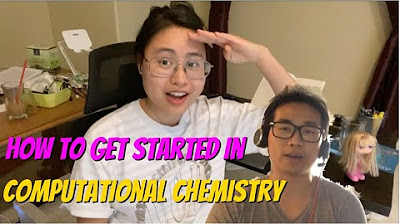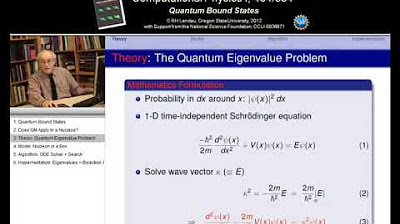0. Intro to All These Lectures (README!!)
TLDRProfessor Reuben Landau introduces a computational science course at Oregon State University, emphasizing hands-on learning with computers to solve scientific problems. The course covers basics, error handling, visualization, and programming, leading to more complex topics like Monte Carlo simulations and solving ordinary differential equations. It aims to prepare students for interdisciplinary work, highlighting the importance of understanding both the science and the computational tools involved.
Takeaways
- 👋 Introduction: The script is from a computational science class, led by Professor Reuben Landau and Sally Hair, focusing on introducing students to the field and its methodologies.
- 🏫 Institution: The class is conducted at Oregon State University, with support from the National Science Foundation and the Engaging People in Cyber Infrastructure program.
- 📚 Course Material: The course is based on a book titled 'A Survey of Computational Physics' by Reuben Landau, Manuel Baez, and Christian Bordiano, published by Princeton University Press.
- 🔍 Focus: The course aims to teach students how to use computers for scientific problem-solving, emphasizing practical application over theoretical knowledge.
- 💻 Technology: Java is the primary programming language used in the course, though other compiled languages are also mentioned.
- 🔬 Practical Approach: The course encourages hands-on learning, with an emphasis on understanding the 'inside the box' mechanics of computational processes.
- 🎓 Target Audience: The course is designed for undergraduates, with a background in basic computing and an interest in scientific computing.
- 📈 Course Structure: The lectures are video-based with PowerPoint slides, available for viewing online with options for customization to fit local class needs.
- 👂 Accessibility: The lectures are designed to be accessible, including features for the hearing and visually impaired, with alternative formats available upon request.
- 🔧 Tools and Software: The course discusses various tools and software for computation, including Java Development Kit, visualization software, and scientific libraries.
- 🧠 Paradigm Shift: Computational science has become a foundational pillar of scientific research, alongside theory and experiment, offering new ways to explore and solve complex problems.
Q & A
What is the main focus of the first class in computational science?
-The main focus of the first class is to introduce the students to the course, the instructors, and the general objectives of the class. It also aims to give an overview of what computational science is and how it will be taught.
Who is Reuben Landau and what is his role in the class?
-Reuben Landau is a professor of physics at Oregon State University and a computational physicist. He heads the computational physics program for undergraduates and is one of the instructors for the computational science class.
What is the role of Sally Hair in the computational science project?
-Sally Hair is a computational scientist who works as the director, editor, and producer for the computational science project. She is responsible for the behind-the-scenes work and contributes to the class.
What does the acronym 'CX' stand for in the context of computational science?
-In the context of computational science, 'CX' stands for 'Computational X', where 'X' could be any field such as physics, biology, finance, or genetics, indicating the application of computational methods to various scientific disciplines.
What is the importance of using headphones while listening to the lectures?
-The importance of using headphones is to ensure that the lectures do not disturb others, especially in a laboratory setting, and to allow for better control of the volume.
Why is it recommended to read the accompanying book for the lectures?
-Reading the book is recommended because it contains more detailed information than what can be covered in the lectures. The book provides a deeper understanding of the concepts and serves as a valuable resource for students.
What is the significance of the course being unscripted?
-The course being unscripted allows for a more natural and engaging learning experience. It reflects the real-world application of knowledge and encourages students to learn by doing, rather than just listening to a prepared script.
What is the philosophy behind the teaching approach in the computational science course?
-The philosophy behind the teaching approach is that the best way to learn computation is by doing it. It emphasizes hands-on experience and understanding the process of computation, rather than just viewing it as a 'black box'.
What are some of the software tools recommended for the course?
-Some of the recommended software tools include the Java Development Kit, various visualization software like New Plot and OpenDX, and scientific libraries such as Jama for matrix operations.
How does the course approach the teaching of computational science to students with different needs?
-The course provides materials in various formats to accommodate different learning needs, including audio for the visually impaired and LaTeX versions of slides for those who require a more hands-on approach.
Outlines
👋 Introduction to Computational Science Course
The video script introduces a computational science course, welcoming students to the class and highlighting the course's objectives. Reuben Landau, a professor of physics at Oregon State University, and Sally Hair, the director and editor, introduce themselves. The course aims to teach students how to use computers for scientific problem-solving, assuming prior knowledge of basic computing skills. The script mentions the support from Oregon State University, the National Science Foundation, and the Engaging People in Cyber Infrastructure program. It also introduces the course material based on the book 'A Survey of Computational Physics' by Reuben Landau, Manuel Baez, and Christian Bordiano. The lectures will be video-based with PowerPoint slides and are designed to be viewed flexibly, with options to read the book before or after watching the lectures.
📚 Utilizing Lectures and Course Materials
This paragraph discusses how to make the most out of the video lectures and accompanying book. It emphasizes the importance of reading the book for more in-depth information than what can be covered in the lectures. The script explains that the lectures are less formal and aim to convey key concepts. It also describes the technical aspects of viewing the lectures through a web browser, the availability of a table of contents for easy navigation, and the option to stop, pause, or repeat sections as needed. The paragraph encourages the use of headphones, especially in a laboratory setting, and mentions the availability of additional materials such as programs, applets, color animations, and visualizations that can be customized for local classes.
💡 Philosophy and Practicality of Computational Learning
The paragraph outlines the philosophy behind the course, which is centered on the belief that the best way to learn computation is by doing it. It argues that computing can motivate students to learn more about science and mathematics. The script advocates for creativity with computers and hands-on experience, moving away from the outdated view of computation as a 'black box.' It also touches on the importance of understanding what goes on 'inside the box' and encourages students to get 'dirty' with practical applications. The paragraph mentions the use of sample codes to save time and allow for exploration, and it highlights the value of projects as a means of personal investigation and learning.
🛠️ Recommended Software and Learning Tools
This section provides recommendations for software and tools that students should use for their computational projects. It emphasizes the importance of using a properly equipped computer for practical work, rather than a generic laptop. The script lists several pieces of software, including the Java Development Kit, various visualization tools, and matrix libraries, all of which are free and can be used across different platforms. It also suggests learning to use different editors and shells, and it touches on the importance of understanding computer hardware and tuning for better performance in computational tasks.
🔬 The Changing Nature of Scientific Research
The paragraph discusses the paradigm shift in scientific research due to the rise of computational science. It explains how computation and simulation have become fundamental pillars of scientific inquiry, complementing theoretical and experimental approaches. The script encourages students to explore models of the real world using computers to solve complex problems that may be beyond analytic solutions or human endurance. It positions the computer as a tool for calculation, a simulated laboratory, and an intellectual lever, highlighting the freedom and opportunities that computational science offers to both students and professionals in the field.
🌐 Computational Science as a Multi-Disciplinary Field
This section delves into the multi-disciplinary nature of computational science, distinguishing it from traditional interdisciplinary approaches. It explains that computational science involves elements from computer science, applied mathematics, and the specific scientific domain (the 'x' in 'computational x'). The script uses a ven diagram to illustrate the overlap and integration of these fields, emphasizing the commonality of techniques and methods across different scientific disciplines. It also contrasts computational science with computer science, highlighting the different focuses and objectives of each field.
📈 Course Structure and Problem-Solving Paradigm
The paragraph outlines the structure of the course and its adherence to a problem-solving paradigm. It describes the process of moving from a scientific model to a computational model, simplifying theories, and using numeric or symbolic methods to solve problems. The script discusses the importance of implementation, where students learn to write programs, and assessment, which involves checking and debugging work. It also mentions the use of visualization as a tool for assessment and debugging, and it provides an overview of the course topics, which include computational basics, errors and uncertainties, trial and search errors, visualization, object-oriented programming, and more.
🧠 Concept Map and Course Overview
The final paragraph presents a concept map that visually represents the interconnectedness of the topics covered in the course. It provides a big-picture overview of the course material, showing how mathematical concepts, scientific applications, and computer science tools are interlinked. The script highlights the importance of understanding these connections and how they apply to the study of computational science. It ends with an encouraging note, suggesting that students may initially find the material challenging but will eventually overcome their fears and develop a love for the subject.
Mindmap
Keywords
💡Computational Science
💡Scientific Computing
💡Java
💡Compiled Languages
💡Monte Carlo Simulations
💡Visualization
💡Object-Oriented Programming
💡Numerical Methods
💡Critical Thinking
💡Interdisciplinary
💡Educational Paradigm Shift
Highlights
Introduction to computational science and its application in various scientific disciplines.
The course is designed for students with basic knowledge of operating systems and programming.
Focus on using Java for computational tasks, with mentions of other compiled languages.
Emphasis on the importance of understanding the material beyond just the programming aspect.
The value of the book 'A Survey of Computational Physics' for course material.
Recommendation to read the book alongside lectures for a comprehensive understanding.
The flexibility of viewing video lectures and the use of a Flash-enabled web browser.
The accessibility of lectures with controls for pausing, stopping, and repeating sections.
The encouragement of using headphones for better focus and reduced disturbance in shared environments.
The role of the computer as a tool for computation, simulation, and an intellectual lever.
The philosophy of learning computational science through hands-on experience and practical applications.
The shift in scientific research paradigms to include computation as a foundational method.
The interdisciplinary nature of computational science, combining elements of various fields.
The importance of understanding the underlying algorithms and mathematics in computational science.
The use of sample codes to save time and encourage exploration and customization by students.
The expectation for students to learn how to compute effectively and understand the process.
The recommendation of various software tools for visualization and scientific computing.
The course's structure around the problem-solving paradigm in computational science.
An overview of the course topics, including computational basics, errors, uncertainties, and various computational methods.
The concept map illustrating the interconnectedness of the subjects covered in the course.
Transcripts
5.0 / 5 (0 votes)
Thanks for rating:





